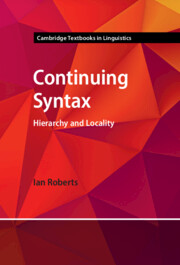Book contents
- Continuing Syntax
- Cambridge Textbooks in Linguistics
- Continuing Syntax
- Copyright page
- Contents
- Preface
- Abbreviations
- Part I Configuration and Hierarchy
- Part II Locality
- 10 Wh-Movement: Unbounded Dependencies, Islands, Subjacency and Barriers
- 11 Covert Movement, Copy Theory and Reconstruction
- 12 Phases and Phase Impenetrability
- 13 Types of Locality: Phases and Relativised Minimality
- 14 The Syntax of Silence I: Ellipsis
- 15 The Syntax of Silence II: Empty Pronouns
- 16 Wrapping up: Parameters, Features and Futures
- Glossary
- Book part
- Index
- References
15 - The Syntax of Silence II: Empty Pronouns
from Part II - Locality
Published online by Cambridge University Press: aN Invalid Date NaN
- Continuing Syntax
- Cambridge Textbooks in Linguistics
- Continuing Syntax
- Copyright page
- Contents
- Preface
- Abbreviations
- Part I Configuration and Hierarchy
- Part II Locality
- 10 Wh-Movement: Unbounded Dependencies, Islands, Subjacency and Barriers
- 11 Covert Movement, Copy Theory and Reconstruction
- 12 Phases and Phase Impenetrability
- 13 Types of Locality: Phases and Relativised Minimality
- 14 The Syntax of Silence I: Ellipsis
- 15 The Syntax of Silence II: Empty Pronouns
- 16 Wrapping up: Parameters, Features and Futures
- Glossary
- Book part
- Index
- References
Summary
In this chapter, we look at empty pronouns: cases of ‘silent deep anaphora’. More specifically, our focus is on null subjects, i.e. silent pronominal subjects, in a range of languages. We identify three main types of null-subject languages and attempt to explain the typology. This leads us to the investigation of the parametric variation across languages.
Information
- Type
- Chapter
- Information
- Continuing SyntaxHierarchy and Locality, pp. 290 - 303Publisher: Cambridge University PressPrint publication year: 2025
